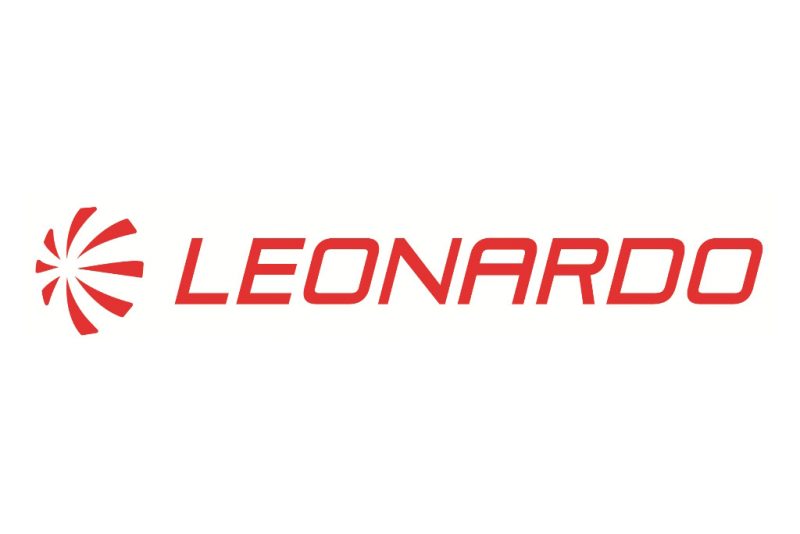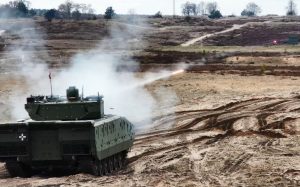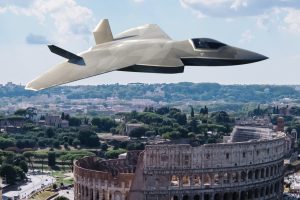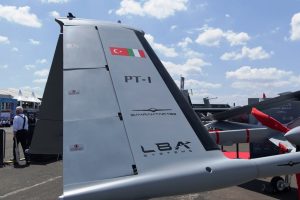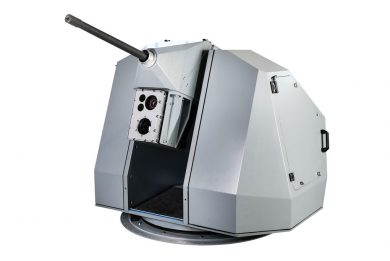Leonardo CEO details the status of recent large-scale initiatives at Q3/25 press conference
At the press conference organised in Rome for illustrating Q3 results Roberto Cingolani, Leonardo CEO, illustrated the status of the many large-scale initiatives, which include new joint ventures and acquisitions, the company launched in the recent past
Following the announcement that the company Chief Financial Officer, Mrs. Alessandra Genco, is leaving Leonardo for personal reasons, Cingolani thanking her and whishing her good luck for the future, and after discussing the quarterly results that EDR On-Line readers can find in the Business News 3rd Quarter 2025 Results, the CEO detailedthe status of the numerous large-scale initiatives that have materialized in recent months, most of them becoming part of the company organic growth as they are incorporated in the company planning.
A few hours after receiving a contract for the supply of the first 21 of the over 1,000 A2CS tracked armoured vehicles for the Italian Army, all in the “Combat” version, a contract filed to the temporary grouping of companies formed by Leonardo and Rheinmetall, the precursor of LRMV, the Leonardo Rheinmetall Military Vehicles joint venture, Cingolani detailed the status of the cooperation between the two defence giants. “Right now, 400 million have been allocated on the A2CS and the second phase of the programme is supposed to be launched very soon,” Cingolani announced adding that the first five vehicles will be delivered by year end, showing the delivery chart which specifies the deliveries of the A2CS and the Main Battle Tank (MBT) from 2025 to 2040. “The challenge here is to have a very efficient integration of top-notch electronics, weapons control systems and top-notch military carriage technologies,” he pointed out.
Compared to the chart shown in early February when LRMV first detailed the two programmes some changing occurred. “For the main battle tank, we expect the first prototype between 2029 and 2030,” Cingolani said, underlining that the MBT issue is more complicated than the infantry combat vehicle. In the original chart the first deliveries of the new MBT and its derivatives, bridge layer, engineering, and recovery variants, was planned for 2027, first MBTs now being expected in 2028, although the CEO statement puts this one year to the right. The ramp up of the overall deliveries is also shifted, the original plan forecasting an aggregate delivery, A2CS plus MBT, of 104 platforms in 2029, the new plan showing this number in 2030, with 34 MBT and 70 A2CS platforms that year, peak deliveries being moved from 2030/31 to 2031/32, however with higher numbers, respectively 180 versus 160 and 190 versus 171, all MBT-based variants to be delivered by 2033, two years earlier than in the previous timeline. It is confirmed that the first five A2CS will be delivered in the Hungarian version, that is with the Rheinmetall 30 mm turret rather than with the Leonardo turret, which will be armed with the newly developed X-Gun.
Cingolani then switched to the GCAP, the Global Combat Air Programme that sees the UK, Italy and Japan working on a 6th generation air dominance system. In a scenario in which the competitors like those in the US or like in Europe seem to progress very slowly, if they are progressing, GCAP is really now up and running,” he stated underlining that Edgewing, the joint venture headquartered in Reading, UK, was incorporated in June 2025 and equally owned by BAE Systems (UK), Leonardo (Italy) and Japan Aircraft Industrial Enhancement Co. (Japan), in charge of coordinating the activities of the three national companies (NATCO) and is leading the design and development of the new generation combat aircraft which is expected to enter into service in 2035 and operate beyond 2070. EDR On-Line understood that Edgewing has now around 180 personnel, the target being 200-250, new governance and operational procedures being also in place. “In the meantime, we have launched the consortium that involves Leonardo Mitsubishi and others to deliver the next gen of ISANKE, the Integrated Sensing And Non-Kinetic Effect electronics and the ICS, the Integrated Communication System,” the CEO underlined, adding that those are fundamental crucial elements of the GCAP architecture, as they represent the hearth of the communication and control system. He also highlighted that at NATCO level, therefore at Italian level, a substantial budget has been secured, saying that by the end of the year Italy will assign over 1 billion, which will be used to cover three main areas; the national technology programme that should essentially incorporate high performance computing and AI technologies into the building blocks of the future GCAP architecture; the concept and the assessment phase for the adjunct, the fighter drone that could be controlled by GCAP or by any other sixth generation fighter; and finally the working environment and the digital infrastructure that will control all the components of the system of systems. “There is also another good news,” Cingolani said, “as GIGO, the GCAP International Government Organisation, the governmental structure on top of the GCAP, is currently discussing and negotiating the first international contract that will be provided to Edgewing, and that money will boost the activity of the three NATCOs.” These funds will be invested not only in national activities but in coordinated sovereign national activities of the GCAP consortium, having to do primarily with the platform. “So apparently, the GCAP machine is moving, the company is up and running and I think if we work seriously and we’re all committed in getting the results on time, our GCAP roadmap will grow properly,” Cingolani concluded.
At Le Bourget last June Leonardo and Baykar announced the creation of LBA, Leonardo Baykar Advanced systems, the joint venture between the two companies active in the unmanned air systems domain.
The two companies are working on the regulatory approval, needed in such a sovereign national joint alliance. One main issue is certification: “We are thinking of an industry that massively produces machines of different payloads, different sizes, and we want to have machines that are certificated and can be sold everywhere in the world,” Cingolani stated, adding that the two companies are already active in integrating payloads and platforms.
He then outlined how the new JV will operate in Italy, as it will impact several production sites. Historically the home of Italian drones is the plant in Ronchi dei Legionari, where then Meteor started this business, the company being acquired in 1993 by then Finmeccanica. This facility is the one where the Falco is produced; “Here we are going to make the final assembly of the TB3, and in the meantime, we are also improving the Mirach.” The latter is a jet-powered drone with a 200 km range and an approximately 50 kg payload a Leonardo platform. “Integration of electronics, payloads, sensors, weaponization, will be done here, starting from these two platforms,” the CEO explained. In Villanova d’Albenga, close to Genova, LBA will make the final assembly of TB2 and Akinci, the latter being the biggest machine, with its 22 metres wingspan. The plant belongs to Piaggio Aerospace, the company being part of Baykar since June 30th, 2025. In Torino, where Leonardo has a lot of aviation activity, LBA will concentrate engineering and certification activities, while in Rome, the company is developing in the new multi-domain facility that will deal with all the technology needed to govern the multi-domain situations that involve drones. “Finally, in Grottaglie, which is our plant for civil aircraft, carbon compounds, and we are going to make composite manufacturing and final assembly of the Kizilelma,” the fighter drone developed by Baykar that the Leonardo CEO indicates as the adjunct, previously mentioned as the GCAP ‘loyal wingman’, which will obviously be available also to other 6th generation fighters. Of course, LBA, and Leonardo on his side, are investing to upgrade the production lines in the aforementioned facilities.
At the half-year results press conference Roberto Cingolani announced that Leonardo has acquired IDV, the defence branch of Iveco. Three months later Leonardo CEO detailed the status of that deal. “First of all, we are working on a regulatory approval and of course, we are negotiating to ensure the deal closing,” he underlined adding that there are a few key points that must be cleared. The first one is securing the internal supply chain, as IDV was part of the wider Iveco family, and the commercial side of it has been acquired by a foreign entity. This was providing key components to IDV, namely engines, and this link must be guaranteed at least for a defined period of time. “In cooperation with the Italian Government, we are working to the prescriptions in the golden power to make sure that this internal supply chain will be ensured for at least one decade under the same conditions,” he stated, adding that negotiations are going on very well.
The other issue is related to IDV trucks, the second product line, the first being that of armoured vehicles. Keeping the IDV businesses together, all absorbed by Leonardo, was one option, splitting the two, the truck business being acquired by the company German partner, Rheinmetall, which is active in that field through RMMV, Rheinmetall MAN Military Vehicles, being the second option.
“Currently our teams are working together, we are studying all the perspectives. It is yet unclear, because due diligence is in progress, whether it’s more convenient to keep things together or to carve out them,” Cingolani explained. An industrial analysis is ongoing, EDR On-Line understood, to evaluate how much synergies between trucks and payloads, such as guns, missiles, radars, and other systems, might provide new market opportunities. “It will depend, of course, on the financial and commercial analysis, which is in progress,” he concluded.
Another interesting domain is that of Unmanned Ground Systems, UGVs. Leonardo is staring considering these products together with IDV, which UGVs range from 600 to 2,000 kg, and can transport different payloads. Having UGVs together with all the other manned platforms is very appealing, according to Cingolani, “So there is a special focus in our technical and commercial teams about those system.”
The acquisition of IDV will allow Leonardo to offer its customers both tracked and wheeled combat vehicles, the merging of the two businesses bring to the disbanding of the Consortium know as CIO, for Consorzio Iveco-Oto Melara, which was formed in the 1980s to create a single interlocutor towards the Italian Defense Administration, bringing together propulsion, wheeled, and tracked platforms, turrets, guns and effectors. According to information gathered by EDR On-Line the CIO should cease to exist in Q2/26, the closure of the IDV acquisition by Leonardo being forecasted in Q1/26.
From land back in the air, Leonardo CEO switched to aerostructures. In February this year he announced that, following the issues due to the problems of Boeing, the company had identified a new industrial partner, which remains unknown for the time being. Without mentioning it, Cingolani stated that “The very good thing is that we are really progressing according to the agenda. In July our potential partner approved our standalone plan and gave a very positive evaluation, both financial and technical. Now they are making their own standalone plan that should be complementary to ours to create synergies.” Personnel from the two companies is working together in both places. “We have a quite consistent joint working group, we are working at the same time with the key stakeholder, and needless to say, we share our vision and the idea of this joint venture with our main customers, those for which we build the components,” the Leonardo CEO explained. Work is also advancing on the joint venture governance and organisation, which comes out of the industrial choice, but also on the sovereign national character of the initiative. Albeit he defines the negotiation ‘very complex,’ he also stated that “We maintain our target to sign the partnership agreement by the end of the year.”
A key issue in the current period is manufacturing capacity, the Russia-Ukraine war having highlighted the need for mass production, something that was forgotten in decades of peace. Leonardo announced three months ago its concept of capacity boost. “The capacity boost team and the external advisor are now focussing on a number of specific actions,” three elements being deemed critical, engineering, manufacturing, and supply chain. “Engineering is responsible for 30 to 40 percent of the extra workload, millions and of hours that are necessary to improve the efficiency in production. Manufacturing is responsible for at least 10 to 15 percent of the extra workload necessary to improve our capability. Finally, in the supply chain we have identified 10 to 20 percent of the strategic suppliers which are classified as critical, and this has to be addressed by the capacity boost,” Cingolani explained. Leonardo is addressing the engineering problem working essentially on digitalisation, to improve the process efficiency. The aim is to have more hours, as a lower price and increase focus on collaboration. “We are working a lot on talent attraction. There is a first talent attraction campus close to Naples, but this is now being extended to many other manufacturing areas and engineering areas of Leonardo,” he stated adding that, “Within the industrial plan period we consider hiring 17,000 people, partly replacing retirements, around 9,000 or so, but most of them fresh brains.”
As for manufacturing, here to the aim is to reduce inefficiencies, and several case studies are being analysed. One concerns La Spezia, where a strong improvement programme is considered for land defence programmes, a key issue in the light of the mass production of armoured vehicles planned for the Italian Army through the LRMV joint venture. Further investments are being done in Cameri, Caselle and Venegono, all aircraft-related facilities. “Process engineering, rules, supply chain, warehouse organisation, there is a lot to be done and we are working full time on that.”
Roberto Cingolani also mentioned the “Mixing the Blood” programme; “We cannot do independent industrial plants because we belong to the same multinational company. There must be synergy.” The Mixing the Blood programme means that soon we will see top managers from the UK working in Italy, Italian ones working in the US, American ones working in the UK, and so on. “The Mixing the Blood programme is carried out by a team of Human Resources strategy operations in collaboration with the divisions and the plants, because we have to accomplish this in the next six months,” Cingolani explains.
One concern is related to the Yeovil factory; “This plant is not getting industrial public grants from the UK government for 14 years. I was recently in the UK, I spoke to the Under-Secretary of Defence, Honourable Healey. I will meet him again in Naples mid-November, and we are trying to boost the collaboration with the UK government.
The creation of Bromo, the joint venture that will see the participation of Airbus (35%), Thales and Leonardo (32.5% each) and will be based on the five NATCOs, in Italy, France, Germany, Spain and UK. “We are going to work in the next, let’s say, 18 months to make this thing happen for real,” he announced, adding that currently the revenue profile is approximately 6.5 billion, with 25,000 people involved, the synergies g half a billion, being very conservative.
The last announcement was for the Michelangelo Dome, a concept of air defence dome that should be customer-friendly, very flexible, adaptable to any effect or any missile, any weapon. “Not a rigid system, but something which really makes the difference because it essentially takes advantage of all the strategic choices that Leonardo has been doing in these three years,” Cingolani said, adding that this will be unveiled next 27 November.
Photos and graphics courtesy Leonardo and P. Valpolini

